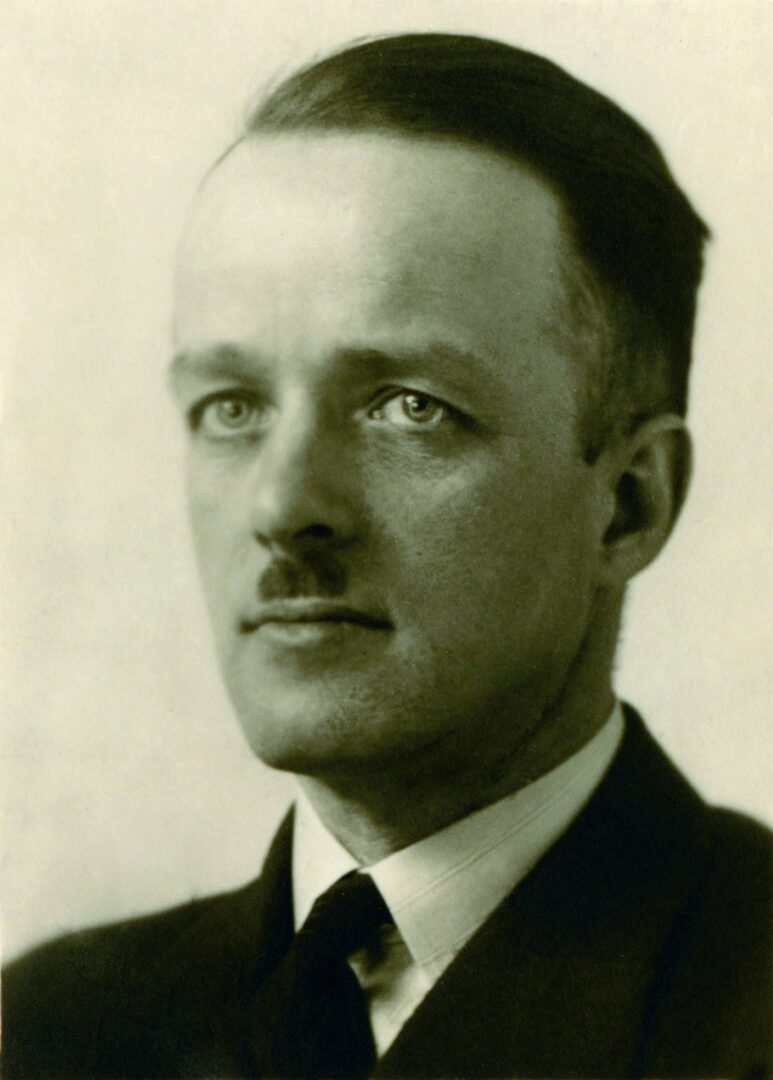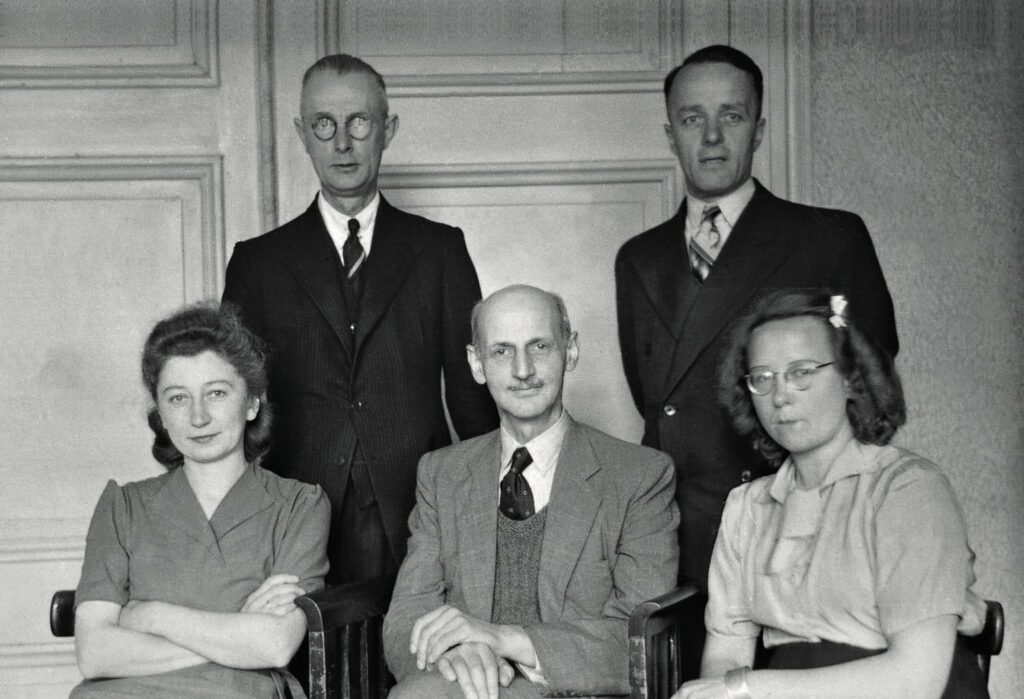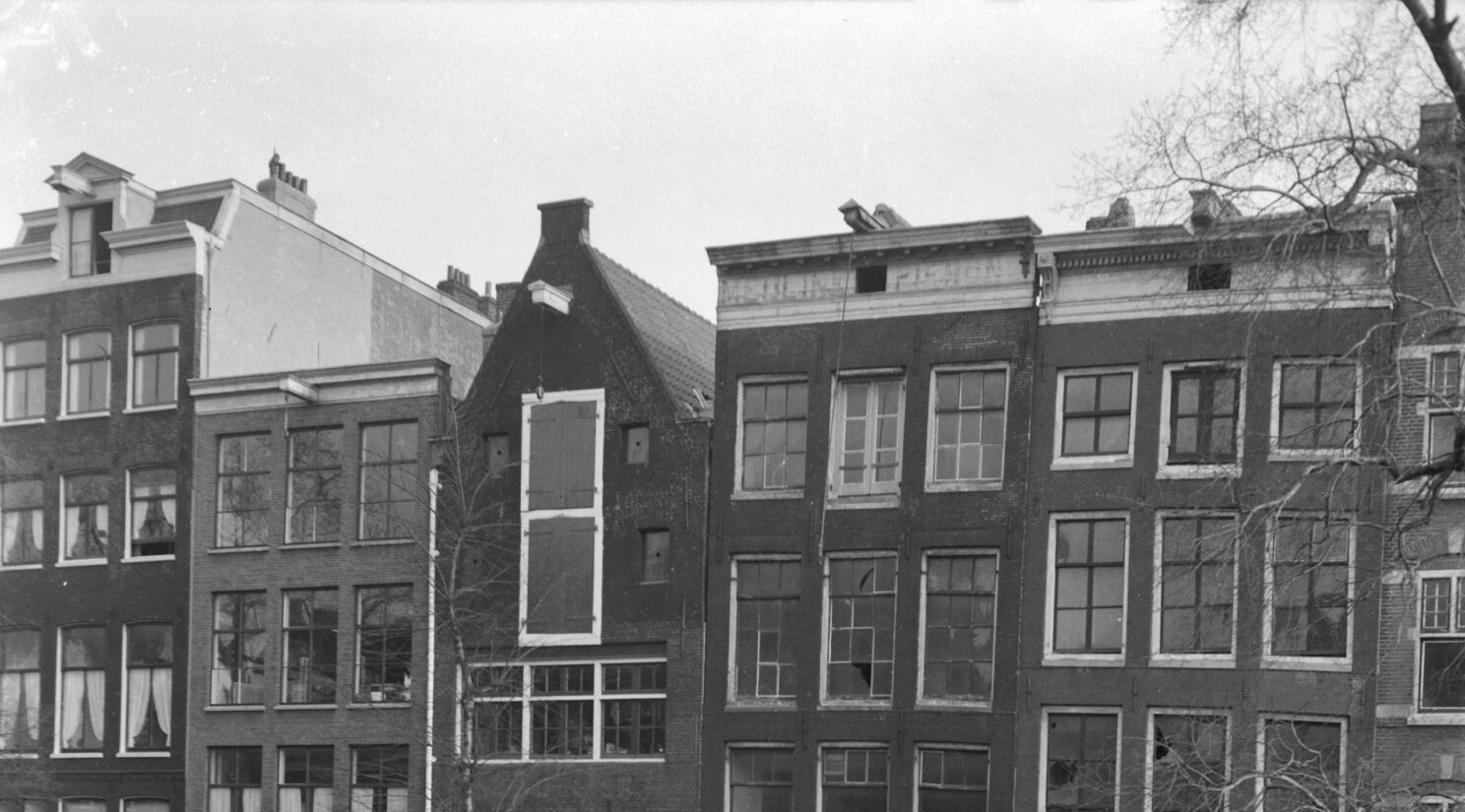Read more:
† 14.12.1981 in Toronto/Canada
Nationality at birth: Austrian, Dutch
Emilia Kuglerova
* 16.11.1877 Jablonné v PodještědíLaura Maria Buntenbach
* 10.05.1895 Zuidbroek† 06.12.1952 Hilversum
Lucie van Langen
* 30.11.1926† 1991
Place of the fight for human rights: Amsterdam
| Area | Type | From | To | Location |
|---|---|---|---|---|
Reason for entry:
Function / Activity:
Literature (literature, films, websites etc.)
„The Man Who Hid Anne Frank“ (1981), Canadian Broadcasting Corporation, Producer and Director: Harry Rasky.
Right to life, freedom and security
Freedom of religion

INTRODUCTION
Prinsengracht 263, Amsterdam, 4 August 1944: The hiding place of the Frank and van Pels families and the dentist Pfeffer is discovered. This marks the end of 25 months of secret life in the back house, which Anne Frank recorded in her diary for posterity. In addition to the people in hiding, helpers were also arrested and taken to Gestapo headquarters in the Euterpestraat: one of them was Victor Kugler. Only about twenty years later does he begin to tell the story from his perspective.
„The man who opened the doors to shelter victims escape from the Nazi hell at a time when the whole world had closed its doors.“ – Charles Wittenberg, longtime friend of Kugler [1]
THE STORY
Victor Kugler was born on 06.06.1900 as the illegitimate son of Emilia Kugler and an unknown father in Hohenelbe in the Austro-Hungarian Sudetenland. He spends four years of his childhood in the Rhineland, but returns to Austria-Hungary. During the First World War he serves in the Austro-Hungarian Navy and is presumably working as an electrician on a submarine. In April 1918, half a year before the end of the war, he was discharged from the army after being wounded. ([2] S. 25-29)
In 1920, Kugler emigrated to Utrecht and initially worked for “Deutsche Maschinenfabrik AG” (Demag) as a machine fitter on a temporary contract. In the early 1920s he met the Dutch woman Laura Maria Buntenbach and married her in 1928. ([3] p. 330)
From 1928 to 1933, Kugler worked as a manager for the company “Pomosin Import Utrecht”. In 1933 he is involved in the decision to consolidate the business at the Amsterdam location. ([2] S. 30)
Collaboration with Otto Frank
After a total of 13 years in Utrecht, Kugler moves with his wife to Hilversum and commutes from there to work in Amsterdam ([2] p. 100). Under the name “Niederländische Opekta Aktiengesellschaft” (Dutch Opekta Corporation), the company focuses on trading in pectin, a gelling agent for jams and jellies. In the late summer of 1933, Otto Frank, an immigrant from Germany, becomes the new managing director and takes over from Victor Kugler as a senior executive ([2] p. 33).
In May 1938, Kugler obtains Dutch citizenship ([3] p. 330). In October of the same year, Otto Frank founds the spice trading company “Pectacon” ([3] p. 135).
In May 1940, the long period of neutrality in the Netherlands comes to an abrupt end with the invasion of the German Wehrmacht. Otto Frank senses the impending consequences and gradually transfers the management of Pectacon and Opekta to his most important employees Victor Kugler and Johannes Kleiman as well as Jan Gies, the husband of Frank’s office assistant Miep. In the context of the decrees on so-called Aryanisation, which are issued shortly afterwards, the companies thus escape expropriation. ([3] p. 164 ff.)
The Jewish Frank family faced increasing repressive measures in the wake of the rise of National Socialism in Germany and as a result had fled to Amsterdam like thousands of others.
The Hiding Place

Prinsengracht 263 in Amsterdam, where the family hid in the back of the house. The photo was taken in March 1957, shortly before the house was converted into a museum.
More and more Jewish men and women are served with compulsory work orders for deportation to Germany. From the spring of 1942, Frank, Kleiman and Kugler arrange for a hiding place to be set up in the long vacant rear building of the company headquarters. There is only a passageway on one floor, which is disguised as a secret door with a bookcase. Since Anne’s older sister Margot is notified on 5 July, the Frank family goes into hiding ten days earlier than planned on 6 July 1942. Specifically screwn hints and rumours point to an escape of the family to Switzerland. ([3] p. 232 ff.)
More people are taken into the hiding place, so that there are eight people hiding in November. Kugler and five other helpers – Johannes Kleiman, Jan and Miep Gies, Johan and Bep Voskuijl – take care of the people in hiding. This is done alternately before and after work or during the lunch break, so that neither the other employees nor neighbours or customers become suspicious.

Otto Frank among the helpers. From left to right: Miep Gies, Johannes Kleiman, Otto Frank, Victor Kugler and Bep Voskuijl. (Copyright: Anne Frank Stichting, Amsterdam / photographer unknown).
Victor Kugler regularly brings newspapers and magazines to those in hiding, informs them about current developments and discusses business matters with Frank Otto ([3] p. 254). In particular, he is responsible for the financial supply, which is particularly important in times of food rationing: If this is to be ensured in the early days through profitable business management, later, when the shortage increasingly turns into a lack of everything, off-the-books spice sales are also necessary ([3] p. 321). He also provided the food stamps with which the survival of those in hiding could be ensured ([2] p. 45).
In addition, Opekta’s independence is jeopardised by the covetousness of the parent company, the Frankfurt-based Pomosin-Werke. In addition to Johannes Kleiman, increasingly impaired by his unstable state of health, Victor Kugler must also ensure that this important source of income is preserved. ([3] S. 332)
During the 25 months she spent in hiding, Anne Frank wrote her world-famous diary, which she had received as a gift for her 13th birthday shortly before. Victor Kugler is immortalised in it as ‘Harry Kraler’. The entry of 28 January 1944 expresses her appreciation to all those who support so-called onderduiker (‘people in hiding’):
… and it is amazing how often, how nobly and how unselfishly this work is done and how people help and save others at the risk of their lives. The best example of this is probably our helpers, who have brought us through so far and hopefully will still bring us to a safe shore. Otherwise they would have to share the fate of all those who are wanted. Never have we heard a word from them that points out the burden that we surely are for them. No one complains that we are too much trouble for them. … Others show heroism in war or towards the Germans, but our helpers prove their heroism in their cheerfulness and love. – ([4] S. 147)
The fateful 4th August 1944
The hiding place is discovered: Under the command of SS-Oberscharführer Karl Josef Silberbauer, Kugler and Kleiman are taken to Gestapo headquarters on Euterpestraat (today’s Gerrit Vanderveenstraat) along with the people in hiding. Kugler will later remember the interrogation that took place on the same day as follows:
As I sat in this dreary room I recognized some familiar objects: Peter van Daan’s new bicycle, the one he got a short time before he and his family went into hiding; a small roll of gold coins belonging to Albert Dussel, and a number of objects which were the property of Mr. Frank. I felt a great pang when I looked at these inanimate objects which had belonged to my friends. These objects were mute witness to the tragic fate which had overtaken all of us.
The interrogation began. “Where were you born?” Silberbauer asked me. I answered proudly, “Austria,“ and followed it up by saying: “I served in the Austrian Navy in the First World War.” I particularly emphasized that, because from his dialect, I noticed that he himself was an Austrian. Maybe the shock was too great for him. First, Mr. Frank – a Jew – an officer in the German Army, and then, somebody from the Austrian Navy. He leaned forward, put out his cigarette, and stopped further interrogation with the words: “That’s enough for today.” – [5]
The exact circumstances of the discovery are still in the dark today; for a long time, treason was considered likely. Investigations into this question are still ongoing today.
Short stops in Amsterdam prisons are followed by longer stays in labour camps in Amersfoort, Zwolle and Wageningen in the period from September 1944 to March 1945. The labour services to be performed and the treatment of the prisoners varied greatly. In Wageningen, Kugler took advantage of an opportunity to pass on sensitive information to the Dutch resistance and the Allies through a fellow prisoner. ([2] p. 75 ff.)
At the end of March, Viktor Kugler is part of a prisoner transport that sets off on foot for Germany. Shortly before the border, the convoy with several hundred prisoners came under British fire and he managed to escape. With the help of helpful farmers and villagers, he was finally able to return to Hilversum. After initially hiding there with his wife, the German Army surrendered four weeks later. ([3] p. 427 f.)
Life thereafter
His wife Laura Maria, in failing health, dies on 6 December 1952 at the age of 57, a few weeks before the couple’s 25th wedding anniversary. It is unclear when Victor Kugler told his wife about his experiences. Due to her longstanding mental illness and the resulting instability, it can be assumed that he did not tell her until late. The exact circumstances of her death remain obscure; however, it is not unlikely that she could not cope with the knowledge of what had happened and that this at least contributed to her death. ([3] S. 428)
On 22 October 1953 Victor Kugler marries his second wife Lucie ‘Loes’ van Langen, who is 27 years younger as him. Business with the spice trade goes badly in the post-war years. In 1955, the company is sold. Viktor and Lucie Kugler follow the example of their two siblings and emigrate to Toronto ([2] p. 87 f.). Kugler was not able to gain a foothold in his previous line of business in Canada either and from then on worked as an electrician and an accountant respectively ([3] p. 428).
In the mid-1960s, Victor Kugler came into contact with the Jewish community in Toronto, which encouraged him to make his life story public ([2] p. 91 f.). Eda Shapiro, herself a Jew with a refugee background, met Kugler through her son in 1969, interviewed him between 1969 and 1971 and recorded his legacy in writing ([2] p. 13 f.).
In April 1973, Victor Kugler is named one of the “Righteous Among the Nations” and is awarded the Order of the Righteous. In 1975 he travels to Israel and plants a tree on the Avenue of the Righteous in the presence of his wife Lucie. In 1979, his memoirs are published by Yad Vashem. ([5]; [2] S. 105 f.)
In the 1970s and early 80s he receives further awards in Toronto and beyond. He becomes known to a wider audience through a documentary of his life: “The Man Who Hid Anne Frank”, produced by Harry Rasky, is broadcast by the Canadian Broadcasting Corporation in December 1980 and later shown by radio stations around the world. Victor Kugler is also a guest on “Front Page Challenge”, Canada’s most-watched TV programme for news and current affairs interviews. ([2] S. 109)
Victor Kugler dies in Toronto on 16 December 1981 at the age of 81 from complications related to Alzheimer’s disease, which characterises the last years of his life ([2] p. 113).
About Victor Kugler
The motives for Victor Kugler’s actions are largely in the dark. During an interview, Kugler answered the question why he put himself in such danger:
„I had to. They were my friends. (…) We helped each other as much as we could. What we could do, we did.“ – ([2] S. 46)
Eda Shapiro speculates that he may have experienced exclusion and discrimination himself in his childhood and youth, as he grew up as an illegitimate child in a region with a reactionary or strictly conservative character. ([2] p. 28 ff.)
Referring to the difficult time in which he took on his role supporting the people in hiding, Otto Frank wrote later that Kugler had been a nervous person and must have suffered from it. He assumed in this context that a possible reason for this could also have been that he had not been able to let his wife in on his activities and thus had not been able to share his worries. ([3] p. 329 f.)
In addition to the special challenges of running the company, nerves of steel were required, as the people in hiding did not want to give up leaving their narrow hiding place after the employees had finished work and move freely around the company premises. This, of course, involved a high risk and led to repeated discussions between Victor Kugler and the people in hiding. Kugler also tried to shield the rear building from the prying eyes of bystanders who might have become suspicious. Apart from the six helpers, the other employees working in the front building during the day did not know about the hiding place. There are reports of at least two risky incidents because of this. ([3] S. 320; p. 332)
In 1944 he also received several calls for labour service. Kugler evaded these with medical certificates, as otherwise he would have been prevented from supporting those in hiding for a longer period of time ([3] p. 330). In view of this, Kugler’s retrospective statement that, in addition to the people in hiding, the helpers who had been initiated were also living in great anxiety and tension is hardly surprising ([2] p. 41).
Victor Kugler is described in the available sources as quiet, correct and attentive to his appearance ([3] p. 100). Eda Shapiro met him almost two and a half decades after the end of World War II and was able to gain a personal impression of him during the extensive interviews. She characterised him as a warm personality with a fine sense of humour ([2] p. 14). As can be seen from the interviews, Kugler was also a religious man of Protestant faith and asked for God’s help in difficult times ([2] p. 61 f.).
Another attribute that can be associated with him is modesty: when Kugler watched “The Diary of Anne Frank” at the Royal Alexandra Theatre in Toronto in 1958, he was so embarrassed by being portrayed that he vowed never to attend another rendition of his life ([2] p. 6).
Closing remarks
This description is representative of the other helpers who supported the eight people in hiding in the back house of the Prinsengracht for over two years at the risk of their lives; here we should mention in particular: Johannes Kleiman, Miep and Jan Gies, Bep and Johan Voskuijl. It should also be mentioned that those named in turn received help from people who were active in the resistance. They all made important contributions to the fact that there was hope until the end.
In addition, this description should also be representative of all other Dutch people who, aware of the possible consequences, selflessly hid so-called onderduikers. Miep Gies put the number of Dutch people who helped Jewish hiders at over 20,000. In 1941, 140,000 Jews lived in the Netherlands, mostly in Amsterdam. Only 6,000 of the 110,000 deportees returned. [7]
Author: Lisa Wilker
Sources:
[1] „VICTOR KUGLER, 81; HID ANNE FRANK“ The New York Times, 17.12.1981, Section D, S. 23. https://nyti.ms/3KDzQiz, last retrieved on 22.02.2023.
[2] Kardonne, Richard; Naftolin, Irving. Victor Kugler: The Man Who Hid Anne Frank. Gefen Publishing House Ltd., 2008.
[3] Müller, Melissa. Das Mädchen Anne Frank – Die Biographie. Fischer-Taschenbuch-Verlag, 2012.
[4] Anne Frank Fonds (Hg.). Anne Frank – Gesamtausgabe: Tagebücher, Geschichten und Ereignisse aus dem Hinterhaus, Erzählungen, Briefe, Fotos und Dokumente. S. Fischer Verlag, 2013.
[5] Shapiro, Eda. The Reminiscences of Victor Kugler – the “Mr. Kraler” of Anne Frank’s Diary. Yad Vashem Studies 13, Yad Vashem, 1979.
[6] „Victor Kugler“. Yad Vashem, https://righteous.yadvashem.org/?searchType=righteous_only&language=en&itemId=4015898&ind=NaN, last retrieved on 15.02.2023.
[7] „Von Angst aufgefressen“. Der Spiegel 19/1987, Seite 223-232, https://www.spiegel.de/kultur/von-angst-aufgefressen-a-156c4d16-0002-0001-0000-000013522680?context=issue, last retrieved on 30.01.2023.
Contact: info@buxus-stiftung.de






